Joint Statement
David Mearns - Search Director, The Finding Sydney Foundation
Lieutenant John Perryman, RANR – Official Observer
At 11:03 (AWT) on Sunday 16 March 2008, a small dark shape was detected coming into view on the starboard side of our SM30 side scan sonar display. In an otherwise featureless seabed. David Mearns soon classified this contact as being man-made, displaying all the characteristics of a major shipwreck. Within minutes a debris field came into view confirming this belief.
The wreck was measured and its position plotted in relation to the wreck of Kormoran and what is firmly believed to be the battle site. Our target was located approximately 10.5 nautical miles to the south-east of the battle site and 12.2 nautical miles from Kormoran. We soon concluded that the modified Leander class cruiser, HMAS Sydney (II), sunk with all hands on 19 November 1941, had been found in 2,468 metres of water. Her position was recorded as being 26° 14’ 37” S 111° 13’ 03” E.
As with the Kormoran find, news of this discovery was promptly communicated to the Finding Sydney Foundation for on-forwarding to the appropriate shore authorities. News of our discovery, only an hour-following the Prime Minister’s announcement concerning the discovery of Kormoran, was received with great emotion and jubilation by The Finding Sydney Chairman, Ted Graham.
With a sense of euphoria onboard we immediately began to make plans to carry out several high resolution sonar passes over Sydney’s wreck. The first of these runs commenced at 18:35 using a 3 kilometer swathe on the SM30 side scan sonar. This run gave us the ability to better measure the wreck and some of the larger pieces of wreckage in the debris field. The run was completed at 18:47.
A second high resolution pass with the SM30 set to operate a 1500 meter swathe began at 23:00 and produced a good image of the wreck lying on the seabed displaying a clear acoustic shadow. This pass also provided an indication that part of Sydney, possibly her bow, may have broken away from her as she limped away causing her to sink. This is a tentative assessment which will have to be confirmed using a suitably equipped ROV with cameras.
The dimensions of the wreck combined with its position in relation to the wreck of Kormoran and the scene of action leave me in no doubt that this is the wreck of Sydney. During the next few days further high resolution runs will be conducted over her wreck and commemorative services will be held for the crews of both Sydney and Kormoran.
This has been a monumental day and one which I hope will bring some comfort to the relatives of those lost in her.
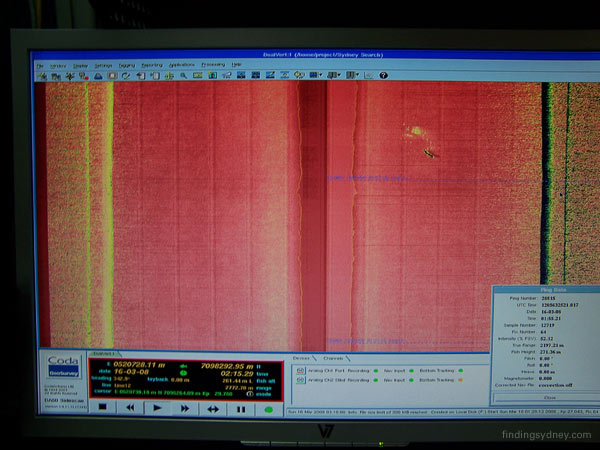
Above Photograph - The wreck of Sydney as revealed for the first time in this wide swathe (6km) sonar image. The wreck is clearly visible on the starboard (right) channel adjacent to a well defined debris field. The height of the wreck above the seabed is causing the dark acoustic shadow just to the right of the wreck.
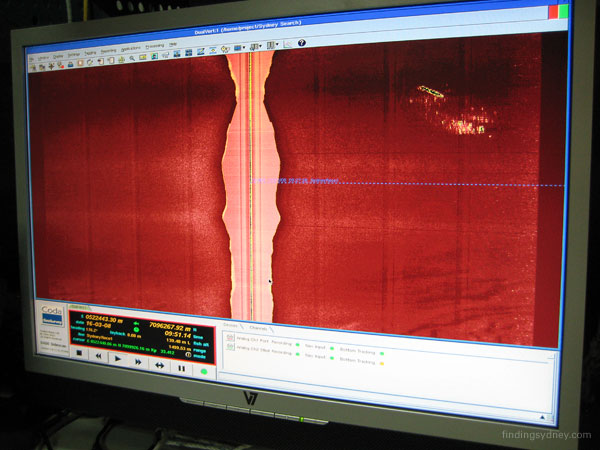
Above Photograph - For this second sonar track we narrowed the SM30 sonar swath to 3km and approached the wreckage on a reciprocal course which is why the image is reversed from above. The wreck and the debris field are better defined in this image, but the main reason for a reciprocal track is to help determine a more accurate position for the wreck on the seabed.
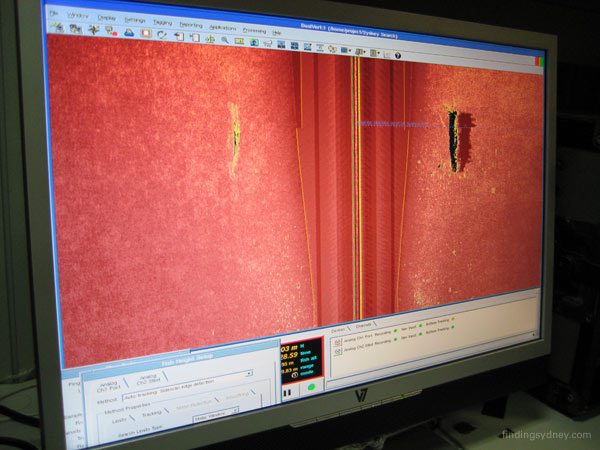
Above Photograph - Sydney 2nd Pass Zoom: This image is a repeat of the image above but zoomed in on just the wreck and debris field. We suspect that the large piece of debris at the lower right hand corner of the image may be a section of the bow which broke away from the hull.
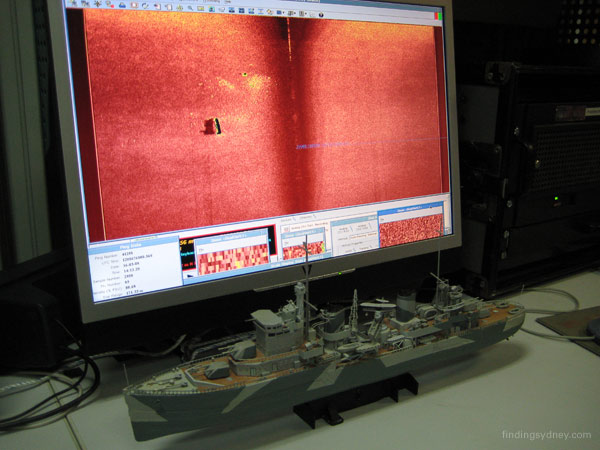
Above Photograph - Image & Model: The third sonar track was narrowed yet again to 1.5km and in doing so revealed the hull and debris field in the most detail to date. Again, the large piece of wreckage at the top of the debris field stands out as the biggest piece, other than the hull itself.
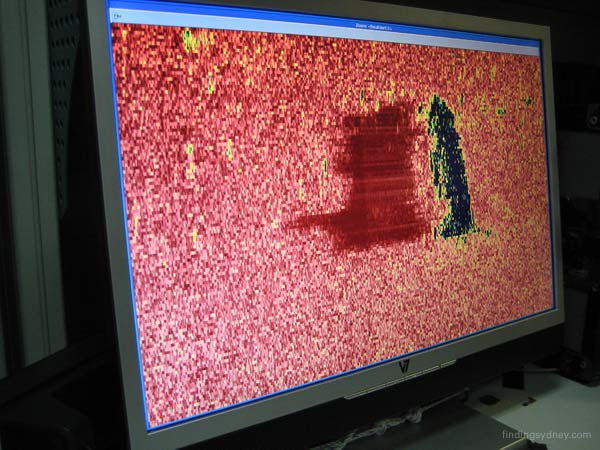
Above Photograph - Sydney Hull: This sonar image is a magnification of just the main hull from the third sonar track. The acoustic shadow to the left of the hull is used to help identify structures that have height. For example we believe that the tallest shadow could be being caused by Sydney’s superstructure. Careful analysis and measurements of the hull length suggest that while the hull is sitting upright on the seabed and is largely intact, a portion of the bow could well have broken away and that this event was the trigger that finally caused Sydney to sink.
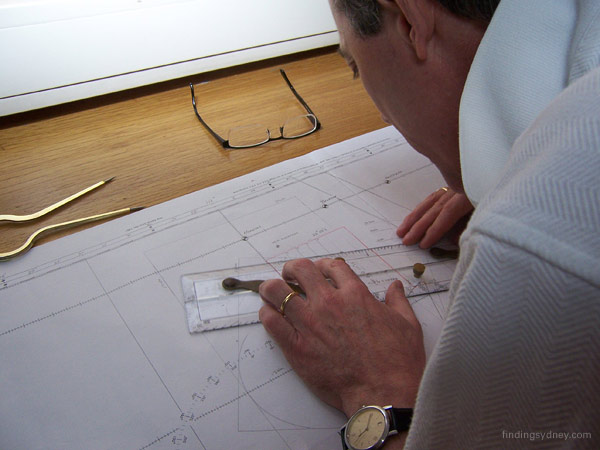
Above Photograph - Search Director, David Mearns plots the location of Sydney’s wreck thus solving one of the most enduring maritime mysteries of the 20th century. David is plotting the position on a Mercatorial Plotting Sheet – the last of four he has made over a period of 5 years whilst conducting his own manual re-navigation of the ship’s tracks and movements during and after the battle.
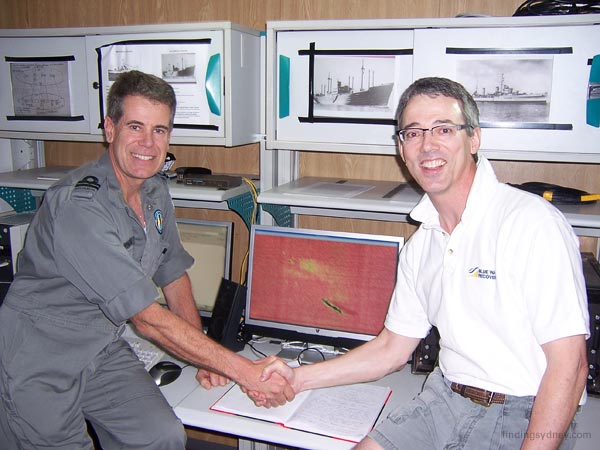
Above Photograph - David & John: A moment of delight shared by Search Director, David Mearns and Lieutenant John Perryman, RANR knowing that the wreck of Sydney had been found ending 67 years of uncertainty about her final resting place.
Glenys McDonald - Director, The Finding Sydney Foundation (Observer)
I woke with a headache this morning. I wanted to be in the survey room between 8am and noon as that was when we thought Sydney would appear on our screens on this track line. The Williamson crew had been tracking a tiny debris trail from the battle area and indications were that this search line would be successful.
At exactly 10:03 am a large piece of wreck unfolded on the screen with a small associated debris field. The surrounding geology was dead flat sandy bottom. There she lay, looking proud and poignant. HMAS Sydney had been found.
John Perryman and I had become adept students in reading the data over the past couple of weeks and we, like David Mearns and the Williamson and Associates crew, knew that this was what we had been looking for. This was the ship that had taken the hopes and dreams of 645 families to the bottom of the ocean.
Here in a relatively small area of ocean we located one ship suffering a catastrophic explosion, a battle site, a small debris trail, and another ship approximately ten nautical miles away sitting proudly on the bottom, all as described by the eye witnesses to this action between HSK Kormoran and HMAS Sydney.
There was jubilation from all, and a few tears from me. David, John and I were thrilled. The Geosounder crew, who had become part of this great project, joined with the Williamson team shaking hands. I thanked the crew and Williamsons on behalf of FSF, and Geoff led a cheer for me which was nice. I just wished that Ted and the other Finding Sydney Foundation Directors were standing beside me.
David then rang Patrick and Ted. I spoke to Ted, and this six foot seven inch giant of a man was overcome. We unashamedly cried together and he asked me if I was certain. I am.
Even though we deserve our moment of jubilation after such a long and difficult journey to this moment in time, we have not forgotten that this was where we lost our men. I went up to the back deck and leant over the railing and cried and gave thanks.
I believe this wreck will bring closure. She sits almost proudly on the bottom. If Sydney had blown like Kormoran there would be little sense of closure, but here in such a large piece and in a depth of water where we will shortly activate the ROV part of the program, we will give the kind of images required for everyone to finally be at peace with this sad story.
We turned the ship around and by 18:35 we were back on site and doing a smaller swath run. The plan is to do a few more of these from different angles before changing the fish over to the SM60: another long night ahead before the official announcement tomorrow.
IMPORTANT NOTICE: The Material (including photographs) available in the "Press Room" section of this Website may be used/reproduced unaltered by your organisation (unless stated otherwise within the content description) subject to the terms and conditions set out in the Legal Section AND any Material (including photographs) which you use/reproduce must credit the source as "The Finding Sydney Foundation" and, as an option, you may also link the source statement with the website address http://www.findingsydney.com/.